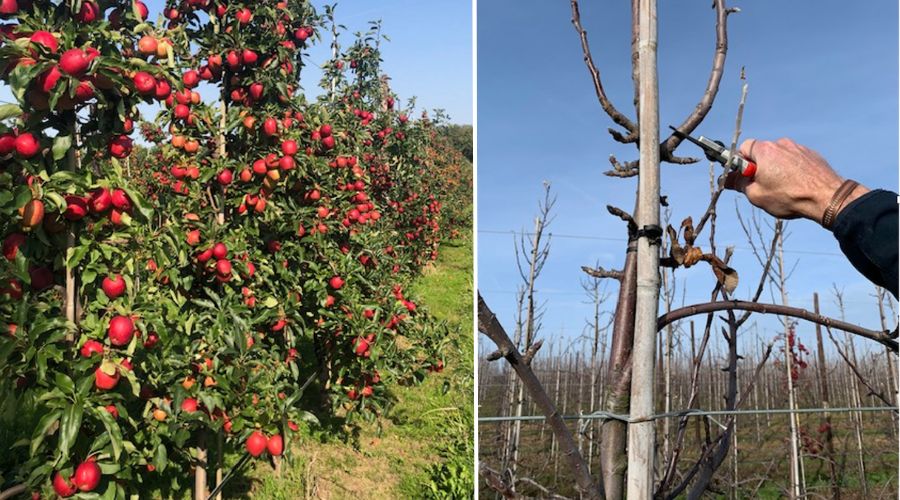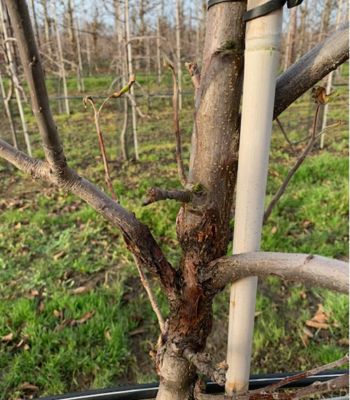Apple tree pruning for high productivity & orchard profitability
17th February 2025
Independent horticultural consultant Mark Holden offers his orchard pruning advice to maximise yields and profitability.

During the winter season, important decisions need to be made regarding the farm pruning strategy.
Correct pruning will define the tree shape, vigour & crop load for that season. It will have a direct influence on further orchard work and associated labour costs, especially during thinning and picking operations.
Structural pruning for tree shape and branch renewal should be carried out in the winter and spring, with summer pruning for vigour control and light management.
Achieving pruning consistency throughout the orchard is essential for high productivity & maintaining fruit quality.
When to prune: This should be based on variety, age of tree, vigour and canker management. Generally prune the oldest orchards first during the winter and those varieties with less canker susceptibility e.g. Bramley, Cox and Jonagold. Leave pruning young orchards and canker susceptible varieties until the spring.
Who should prune: This is determined by the skill set required in each orchard and staff availability i.e. farm and contract labour. The most skilled and experienced workers should prune the younger orchards as these are the future ‘engine room’ of the farm. Aim for pruning consistency from year to year with the same staff pruning the same orchards.

Supervision: This is essential to maintain quality. Avoid large numbers of pruners in one orchard – I personally would prefer one or two workers per orchard to maintain consistency. This does involve more management organisation & time, but the overall results are far better.
Machinery: Electric secateurs and orchard platforms will greatly improve orchard productivity. Avoid ladders or steps in the orchards by dividing the orchard pruning into two jobs i.e. lower and middle part of the tree from the ground & then tops on platforms. This also means the tops can be pruned latter if required to improve the vigour control & achieve a better tree shape.
Price: Hourly or piecework. Monitor the costs against farm budgets, not only by orchard, but also down to individual tree. Piecework rates in most orchard situations will improve productivity, but hourly pay in young orchards with ‘less pruning cuts & more thinking time’ is generally better.
Pruning for productivity and profit

The primary aim of commercial apple pruning is to maximise the kilograms of class one fruit on the tree.
Intensive apple orchards lend themselves to a much simpler form of pruning, as the trees are usually 0.8– 1.0m apart, so there is usually no need to tip the young feathers ‘to fill the space’ or to create complicated branch structures.
Minimal pruning of the young tree in the first three years also promotes more fruit bud & a quicker yield build-up after the planting year. Early cropping in the tree’s life naturally controls the tree vigour without the need for branch manipulation i.e. tying down branches below the horizontal.
As trees reach maturity, remove the two or three problem (i.e. vigorous) branches each year with a ‘Dutch’ or stub cut close to the trunk to maintain the tree’s cropping balance.
Tree balance: Aim for cropping units of a similar diameter range throughout the tree to maintain balance. Remove the problem branches i.e. too vigorous, too upright or too dominant with a size diameter greater than 50% of the tree’s trunk.
Tree architecture and shape: Aim for a tall & narrow ‘A’ shaped tree tapering to the top. This will maximise the light interception which is essential for good fruit bud development, spur leaf quality and associated apple nutrition including sugars (Brix).
Light management: Maximising the light interception and air flow through the tree by evenly spacing the cropping units (branches), will increase fruit colour and the class one percentage.
Crop management: Remove complicated branches which will carry small, poorly coloured fruit. Shorten back droopy wood, especially in the top of the tree, which often bear bunches or ropes of small fruit. This will reduce the hand thinning and orchard costs later in the season.
Vigour management: Pruning the vigorous tops in the summer (ideally after the longest day) will reduce the growth response and rebalance the tree’s shape. This will reduce shading throughout the tree and encourage more fruit bud development for the following season.
Canker management: Prune the most susceptible varieties e.g. Gala, Jazz and Kanzi etc, in the spring when the tree sap is flowing and pruning wounds heal quicker. Pruning young orchards (under four years old) in April/May also reduces potential canker infection, but pruning in dry weather is essential.
Harvest: Many orchards are now picked with harvesting rigs so ensure pickers can easily see and quickly access all the fruit. Apples hidden in the middle of the tree or too low to the ground will be missed, therefore remove these harvest issues through targeted pruning.
About our expert
Mark Holden is an independent horticultural consultant with 35 years of farm management experience in commercial fruit production.
Until 2022, Mark was the Farm Production Director at Adrian Scripps Ltd, managing 400ha of top fruit, grapes and blackcurrants.
Mark’s expertise offer a particular emphasis on orchard design, tree architecture and crop management. Visit www.holdenfruitconsultancy.com
Read more fruit news.
